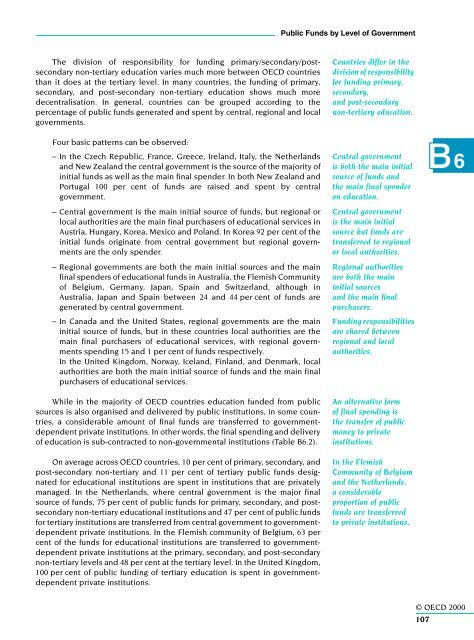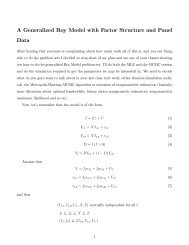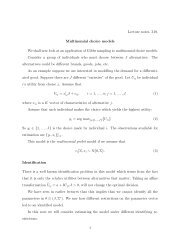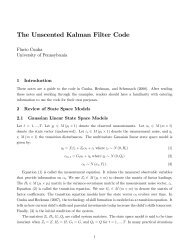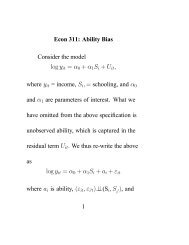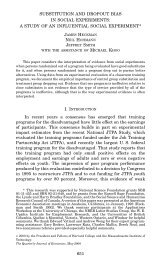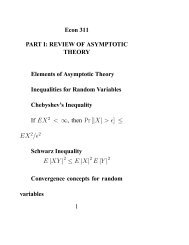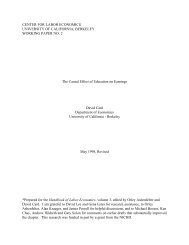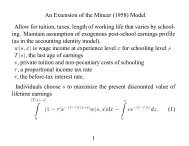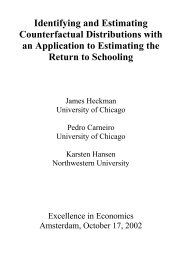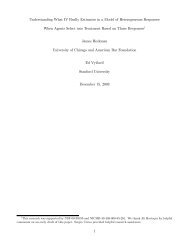OECD (2000)
OECD (2000)
OECD (2000)
You also want an ePaper? Increase the reach of your titles
YUMPU automatically turns print PDFs into web optimized ePapers that Google loves.
Public Funds by Level of Government<br />
The division of responsibility for funding primary/secondary/postsecondary<br />
non-tertiary education varies much more between <strong>OECD</strong> countries<br />
than it does at the tertiary level. In many countries, the funding of primary,<br />
secondary, and post-secondary non-tertiary education shows much more<br />
decentralisation. In general, countries can be grouped according to the<br />
percentage of public funds generated and spent by central, regional and local<br />
governments.<br />
Four basic patterns can be observed:<br />
– In the Czech Republic, France, Greece, Ireland, Italy, the Netherlands<br />
and New Zealand the central government is the source of the majority of<br />
initial funds as well as the main final spender. In both New Zealand and<br />
Portugal 100 per cent of funds are raised and spent by central<br />
government.<br />
– Central government is the main initial source of funds, but regional or<br />
local authorities are the main final purchasers of educational services in<br />
Austria, Hungary, Korea, Mexico and Poland. In Korea 92 per cent of the<br />
initial funds originate from central government but regional governments<br />
are the only spender.<br />
– Regional governments are both the main initial sources and the main<br />
final spenders of educational funds in Australia, the Flemish Community<br />
of Belgium, Germany, Japan, Spain and Switzerland, although in<br />
Australia, Japan and Spain between 24 and 44 per cent of funds are<br />
generated by central government.<br />
– In Canada and the United States, regional governments are the main<br />
initial source of funds, but in these countries local authorities are the<br />
main final purchasers of educational services, with regional governments<br />
spending 15 and 1 per cent of funds respectively.<br />
In the United Kingdom, Norway, Iceland, Finland, and Denmark, local<br />
authorities are both the main initial source of funds and the main final<br />
purchasers of educational services.<br />
While in the majority of <strong>OECD</strong> countries education funded from public<br />
sources is also organised and delivered by public institutions, in some countries,<br />
a considerable amount of final funds are transferred to governmentdependent<br />
private institutions. In other words, the final spending and delivery<br />
of education is sub-contracted to non-governmental institutions (Table B6.2).<br />
On average across <strong>OECD</strong> countries, 10 per cent of primary, secondary, and<br />
post-secondary non-tertiary and 11 per cent of tertiary public funds designated<br />
for educational institutions are spent in institutions that are privately<br />
managed. In the Netherlands, where central government is the major final<br />
source of funds, 75 per cent of public funds for primary, secondary, and postsecondary<br />
non-tertiary educational institutions and 47 per cent of public funds<br />
for tertiary institutions are transferred from central government to governmentdependent<br />
private institutions. In the Flemish community of Belgium, 63 per<br />
cent of the funds for educational institutions are transferred to governmentdependent<br />
private institutions at the primary, secondary, and post-secondary<br />
non-tertiary levels and 48 per cent at the tertiary level. In the United Kingdom,<br />
100 per cent of public funding of tertiary education is spent in governmentdependent<br />
private institutions.<br />
Countries differ in the<br />
division of responsibility<br />
for funding primary,<br />
secondary,<br />
and post-secondary<br />
non-tertiary education.<br />
Central government<br />
is both the main initial<br />
source of funds and<br />
the main final spender<br />
on education.<br />
Central government<br />
is the main initial<br />
source but funds are<br />
transferred to regional<br />
or local authorities.<br />
Regional authorities<br />
are both the main<br />
initial sources<br />
and the main final<br />
purchasers.<br />
Funding responsibilities<br />
are shared between<br />
regional and local<br />
authorities.<br />
An alternative form<br />
of final spending is<br />
the transfer of public<br />
money to private<br />
institutions.<br />
In the Flemish<br />
Community of Belgium<br />
and the Netherlands,<br />
a considerable<br />
proportion of public<br />
funds are transferred<br />
to private institutions.<br />
B6<br />
© <strong>OECD</strong> <strong>2000</strong><br />
107


